

EXPLORE BY TOPIC:
  Our top 10 resources
Our top 10 resources
  Childhood / Early Life
Childhood / Early Life
  Chronic Stress
Chronic Stress
  Education
Education
  Food Security
Food Security
  Genetics
Genetics
  Jobs & Work
Jobs & Work
  Housing / Neighborhoods
Housing / Neighborhoods
  Income & Wealth
Income & Wealth
  Race / Racism
Race / Racism
  Social Inclusion
Social Inclusion
  Policy & Change
Policy & Change





Buy the DVD
e-Newsletter
FAQs
Contact Us
Site Map
Home

|
 |


|
Background: Education is an important predictor of health because it both shapes and reflects so many other factors that affect people's life chances. In fact, many public health advocates believe investing in education is the single most effective intervention we can make to improve health outcomes and tackle inequities. One study estimated eliminating educational inequities would have saved eight times as many lives as were saved by medical advances between 1996-2002.
On average, college-educated men live 6.8 years longer than men who have not graduated from high school, women 5.1 years longer. Adults who have not finished high school are more than four times as likely to be in poor or fair health as college graduates. Babies born to mothers who did not finish high school are twice as likely to die before their first birthday compared to those born to college graduates.
Young people with less schooling are more likely to be unemployed or have unstable and unfulfilling jobs, and low literacy is linked to poverty, disadvantage, social exclusion, and ultimately poor health. In 2004, the median income of male college graduates was 60% higher than male high school graduates, and more than twice that of high school drop outs, the highest income differential ever. Those with masters and professional degrees earned even more.
Education also matters because it can provide us with the knowledge, skills, confidence, connections and opportunities we need to negotiate the world and exert greater control over our lives - what experts call the "pile up" of advantage/disadvantage. How well we do and how far we get in our schooling impact not only our future earnings potential but also our mastery of our environment and our ability to navigate institutions and gain access to power - all of which are consequential to success and wellbeing.
Studies show a clear correlation between health and learning at all ages, from early childhood through adolescence to adulthood. For the youngest learners, early reading and literacy programs stimulate brain development, analytical and communication skills, intellect and behavioral patterns. These in turn shape future opportunities and achievement. Yet we are among the few rich countries not to offer free, universal preschool.
Among adolescents, those who stay in school are less likely to engage in risky behaviors, become teen parents, and end up in dead-end jobs without career prospects. Even among adults, improving basic skills and acquiring new ones enables them to pursue better employment opportunities and gain access to other resources.
But educational resources and opportunities in the U.S. are distributed unequally, reflecting larger patterns of racial and class inequities. Differences in school quality, for example, are due in part to deep patterns of residential segregation and differences in school funding.
Dr. Tony Iton, director of Alameda County (CA) Department of Public Health argues that high school graduation rates represent a snapshot of neighborhood conditions - a lens for viewing larger problems and inequities in specific communities and our society as a whole. In fact, Iton claims that he can predict the life expectancy of a given neighborhood in the county from the high school drop-out rate alone
In California, for example, 90% of students in overcrowded schools are children of color, two thirds of them Latino. Schools in poor districts are notoriously under-resourced, with fewer class offerings, books, computers, enrichment activities and after-school programs. Nationwide, among youth 16 to 24, Latinos accounted for 41% of high school dropouts in 2005, even though they comprise only 17% of the total youth population. Researchers estimate that approximately 2,500 youth drop out of high school every day. In some of the largest school systems in the country - from Baltimore, MD, to Oakland, CA - half of all students are dropping out.
Although many youth later obtain a diploma or GED, the implications of dropping out of high school are enormous, including a higher risk of poverty and a shortened life span. Dr. Iton explains: "Education is huge, because it relates to people's ability to plan and have hope for the future. Without hope for the future, people tend to make short-term decisions," including engaging in riskier behaviors that endanger health.
Today, promising initiatives and ideas to improve our school systems and provide better educational opportunities for everyone abound - but not the commitment to pay for them. We all bear the societal burden of lost productivity, increased disability, higher crime, welfare and prison costs, not to mention the human cost of thwarted hopes, dreams and health.
By foregrounding the life-and-death consequences of educational inequities, perhaps we can find the commitment to create policies that invest in our schools and help forge a long, productive future for all our children.

|
 Accumulating Advantage Accumulating Advantage 
ONLINE INTERACTIVITY based on UNNATURAL CAUSES How do racism and class status get under the skin? How simple is it to just "brush off" experiences with racism? Try this exercise to measure what you are able to take for granted (or not) in your life, and learn how these relate to health. |
 |
 American Federation of Teachers American Federation of Teachers 
WEB SITE "The mission of the American Federation of Teachers, AFL-CIO, is to improve the lives of our members and their families, to give voice to their legitimate professional, economic and social aspirations, to strengthen the institutions in which we work, to improve the quality of the services we provide, to bring together all members to assist and support one another and to promote democracy, human rights and freedom in our union, in our nation and throughout the world." |
 |
 Anthony Iton Interview (pdf) Anthony Iton Interview (pdf) 
EDITED INTERVIEW TRANSCRIPT, Web-exclusive content from UNNATURAL CAUSES In this original interview, Anthony Iton, director of the Alameda County Department of Public Health, talks about the extraordinary health of recent Latino immigrants and what we can all learn from them, the importance of hope, the power of community organizing, and why it's in all our best interest to tackle inequities sooner rather than later. |
 |
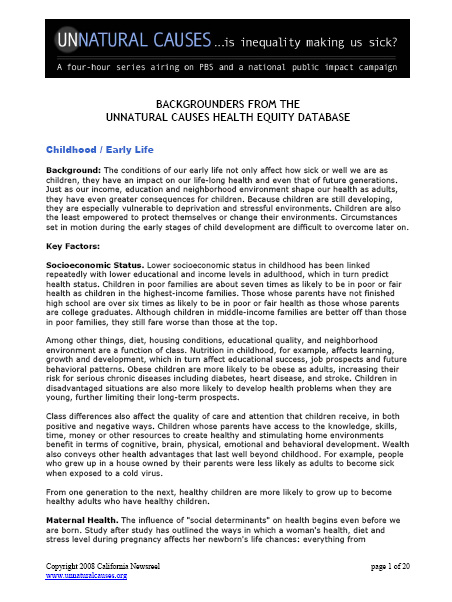 Backgrounders on Health Equity Topics (pdf) Backgrounders on Health Equity Topics (pdf) 
UNNATURAL CAUSES This document by California Newsreel provides an overview of how social concerns such as income, jobs, education, housing, and racism relate to health outcomes and inequities. The short pieces in this document are taken from the topic introductions in the Health Equity database on the UNNATURAL CAUSES Web site. |
 |
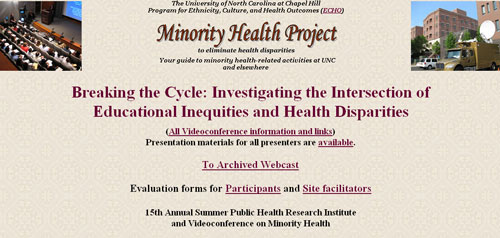 Breaking the Cycle: Investigating the Intersection of Educational Inequities and Health Disparities Breaking the Cycle: Investigating the Intersection of Educational Inequities and Health Disparities 
CONFERENCE VIDEOS from the Minority Health Project to Eliminate Health Disparities, 2009
Includes presentations from:
Reginald Weaver - Vice President, Education International; Past President, National Education Association
Dr. Dina Castro - Scientist, FPG Child Development Institute, University of North Carolina at Chapel Hill
Nicholas A. Freudenberg - Distinguished Professor and DPH Director, Program in Urban Public Health, Hunter College School of Health Sciences/City University of New York
Lillian A. Sparks - Executive Director, National Indian Education Association (webpage)
|
 |
 Center for Education Reform Center for Education Reform 
WEB SITE CER advocates reforms that produce high standards, accountability and freedom, such as strong charter school laws, school choice programs for children most in need, common sense teacher initiatives, and proven instructional programs. Its Washington, DC-based team and state and local partners advance the mission by: making parents better advocates for their children; giving lawmakers knowledge they need to make smart decisions; providing school-based reformers the tools to promote positive change; and building and strengthening education reform leaders in the states.
|
 |
 Center on the Developing Child Center on the Developing Child 
WEBSITE The Center on the Developing Child was founded in 2006 on the belief that the vitality and sustainability of any society depend on the extent to which it equalizes opportunities early in life for all children to achieve their full potential and engage in responsible and productive citizenship. They view healthy child development as the foundation of economic prosperity and strong communities, and our mission is to advance that vision by leveraging science to enhance child well-being.
The site includes a list of the Center's excellent publications.
|
 |
 Charts and State by State Data Charts and State by State Data 
RWJF Commission to Build a Healthier America The Commission provides an in-depth collection of graphical data ready to download into relevant research and presentations on a range of issues from maternal education and infant mortality to income and life expectancy to placing the U.S. in a global context. Charts can be filtered by social factors or by health conditions.
Their State-by-State Data page allows for sorting charts by state and includes an Education and Health Calculator to compare your state to others.
|
 |
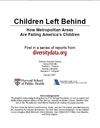 Children Left Behind: How Metropolitan Areas Are Failing America's Children (pdf) Children Left Behind: How Metropolitan Areas Are Failing America's Children (pdf) 
REPORT from DiversityData.org, January 2007
This report finds that across metropolitan America, black and Hispanic children face particularly severe challenges. Inequalities go far beyond what can be explained by income differences, as poor black and Hispanic children tend to encounter environments considerably worse than poor white and Asian children. Yet the very conditions that contribute to these inequalities suggest some possible policy solutions.
The analysis contained in this report is derived from diversitydata.org, a website using data from multiple sources to profile U.S. metropolitan areas's indicators on many dimensions of well-being, including housing, neighborhood conditions, residential integration, education and health. |
 |
 Children Now Children Now 
WEB SITE Children Now is a national organization for people who care about children and want to ensure that they are the top public policy priority. Their actions include: seeking to bridge the gap between public will and public policies; undertaking advocacy on behalf of the whole child; seeking a positive media environment for children; fighting to ensure that all children have access to high-quality affordable health care; working to improve access to quality early care, preschool and after-school programs, and advocating for excellence in K-12 public education for every child; and helping parents talk with their kids about tough issues like sex, AIDS, violence, drugs and alcohol.rolex kopia |
 |
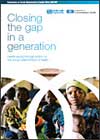 Closing the Gap in a Generation Closing the Gap in a Generation 
FINAL REPORT from Commission on the Social Determinants of Health A project of the World Health Organization (WHO), the Commission on Social Determinants of Health (CSDH) supports countries and global health partners to address the social factors leading to ill health and inequities. It draws the attention of society to the social determinants of health that are known to be among the worst causes of poor health and inequalities between and within countries. The determinants include unemployment, unsafe workplaces, urban slums, globalization and lack of access to health systems.
replica uhren deutschland The Web site also contains final reports from the different knowledge networks, as well as additional background articles and resources. |
 |
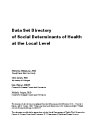 Data Set Directory of Social Determinants of Health at the Local Level (pdf) Data Set Directory of Social Determinants of Health at the Local Level (pdf) 
DATA SETS REFERENCE, Social Determinants of Health Work Group at the Centers for Disease Control and Prevention
The directory contains an extensive list of existing data sets that can be used to address the need for improved conceptualization and availability of data on how the social environment impacts the health of populations. bebek escort The data sets are organized according to 12 dimensions, or broad categories, of the social environment. Each dimension is subdivided into various components.
This directory grew out of a project based at the University of Michigan School of Public Health and funded by the Centers for Disease Control and Prevention (CDC).
|
 |
 Edible Schoolyard Edible Schoolyard 
WEB SITE Founded by chef and author Alice Waters, the Edible Schoolyard is a middle school gardening and kitchen program located in Berkeley, California. Garden classes teach the principles of ecology, the origins of food, and respect for all living systems. Students work together to shape and plant beds, amend soil, turn compost, and harvest flowers, fruits, and vegetables in the on-site organic garden. |
 |
 Editorial: Unemployment and health Editorial: Unemployment and health 
SCHOLARLY ARTICLE by Danny Dorling, BMJ March 2009
Beginning with evidence that unemployment is bad for health and that welfare to work (when the work is low-paid and demeaning) does little to help, this editorial recommends further government support for higher education and quality apprenticeship-style positions.
|
 |
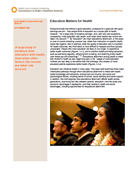 Education Matters for Health Education Matters for Health 
Robert Wood Johnson Foundation Education can influence health in many ways. This issue brief examines three major interrelated pathways through which educational attainment is linked with health: health knowledge and behaviors; employment and income; and social and psychological factors, including sense of control, social standing and social support. In addition, this brief explores how educational attainment affects health across generations, examining the links between parents’ education—and the social and economic advantages it represents—and their children’s health and social advantages, including opportunities for educational attainment. |
 |
 For tribes, traditions may be key to a healthier future For tribes, traditions may be key to a healthier future 
NEWS ARTICLE by Mary Annette Pember, The Washington Post, 2002 Pember looks at efforts in the Ho-Chunk (or Winnebago) tribe of North Dakota to use traditions to counteract fatalism and fight diabetes.
replicas de relojes |
 |
 Free lunch isn't cool, so some students go hungry Free lunch isn't cool, so some students go hungry 
NEWS ARTICLE - New York Times, March 1, 2008 Lunchtime “is the best time to impress your peers,” said Lewis Geist, a senior at Balboa and its student body president. Being seen with a subsidized meal, he said, “lowers your status.”
San Francisco school officials are looking at ways to encourage more poor students to accept government-financed meals, including the possibility of introducing cashless cafeterias where all students are offered the same food choices and use debit cards or punch in codes on a keypad so that all students check out at the cashier in the same manner... |
 |
 Gardening as Cultural Renewal - the Gila Crossing School Program Gardening as Cultural Renewal - the Gila Crossing School Program 
WEB-EXCLUSIVE VIDEO, Unnatural Causes The Gila Crossing Elementary School in southern Arizona was once operated by the Bureau of Indian Affairs. When the local tribe took it over, community members created a gardening program to teach children about their cultural heritage as farmers, to encourage healthy eating, and to foster their development and future interest in agriculture.
|
 |
 Health a Challenge for Hispanic Immigrants Health a Challenge for Hispanic Immigrants 
NEWS ARTICLE by Randolph E. Schmid, Associated Press, 2006 A National Academy of Sciences report calling for more programs to improve educational outcomes among the Hispanic population corresponds with the release of new data from the Centers for Disease Control about Latino health. The longer Latinos are here, the worse their health becomes. Lower educational attainment appears to be one reason.
Swiss automatic Replica Watches UK at affordable prices for men and women.
With Swiss reliable movements, top canada cheap replica watches for men and women are on hot sale. |
 |
 Health Education Resources for ESL Educators Health Education Resources for ESL Educators 
LESSON PLANS (ESOL/ESL) - KQED KQED has developed lesson plans for use with ESL/ ESOL student, using clips from UNNATURAL CAUSES and other media to broaden students' understanding of factors affecting health.
Lessons using the series:
Stress: The Bigger Picture (Not Just a Paycheck / When the Bough Breaks)
This Place Matters: The Impact of Neighborhood on Health (Place Matters and online video)
Living in the United States: Is It Good for Our Health? (Becoming American / In Sickness and In Wealth)
Food Pyramids: What We Eat and Who We Are (Becoming American)
Other lesson plans explore health literacy, the social contexts of drug and alcohol addiction, stress management, and cultural differences in medical practice. |
 |
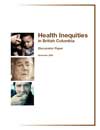 Health Inequities in British Columbia (pdf) Health Inequities in British Columbia (pdf) 
DISCUSSION PAPER, Health Officers Council of British Columbia, November 2008 This report and recommendations from the health officers of British Columbia provides one of the clearest and easiest to understand documents on health equity produced thus far. The first half defines terms, sets a health equity framework, and makes policy recommendations that are widely applicable. The second half focuses on outcomes specific to British Columbia. |
 |
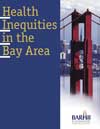 Health Inequities in the Bay Area Health Inequities in the Bay Area 
REPORT from the Bay Area Regional Health Inequities Initiative (BARHII) This report is an attempt to show how the various forces discussed in UNNATURAL CAUSES influence health in the nine-county California Bay Area, and to suggest the kinds of policy initiatives and activities that will be crucial for both reducing the disparities among populations and improving our health overall. |
 |
 Jack Shonkoff Interview (mp3) Jack Shonkoff Interview (mp3) 
PODCAST, Web-exclusive content from UNNATURAL CAUSES In this original interview, Dr. Jack Shonkoff, director of the Center on the Developing Child at Harvard University, discusses the importance of early childhood experiences on life-long health, learning, and success. He describes the effect of toxic stress on brain development, and asserts that we have a moral and economic incentive to provide the best environments for all children or pay the price later in the form of reduced productivity and the burden of chronic disease.
ENHANCED PODCAST (m4a) |
 |
 Jack Shonkoff Interview (pdf) Jack Shonkoff Interview (pdf) 
EDITED INTERVIEW TRANSCRIPT, Web-exclusive content from UNNATURAL CAUSES In this original interview, Dr. Jack Shonkoff, director of the Center on the Developing Child at Harvard University, discusses the importance of early childhood experiences on life-long health, learning, and success. He describes the effect of toxic stress on brain development, and asserts that we have a moral and economic incentive to provide the best environments for all children or pay the price later in the form of reduced productivity and the burden of chronic disease. |
 |
 KIDS COUNT Data Center KIDS COUNT Data Center 
DATABASE created by The Annie E. Casey Foundation A database system that contains state- and city-level data for over 100 measures of child well-being. This easy-to-use, powerful online database allows you to generate custom reports for a geographic area (Profiles) or to compare areas on a topic (Ranking, Maps, and Line Graphs).
2023 Audemars Piguet Replica Watches UK
1:1 fake rolex uk |
 |
| 1 | 2 Next » |
|




